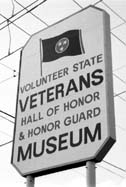
Comment
on this story
Seven Days
Wednesday, Nov. 22
A Knox County couple accused of providing beer to teenagers at a party—one of whom later died in a drunk driving accident—say they did nothing wrong. They admit buying a keg, and they admit it was for a high school graduation party, but they claim they had no intention of giving alcohol to underage drinkers. What, they were gonna use it to taunt the kids?
Friday, Nov. 24
A report from the social activist Institute of Southern Studies ranks Tennessee near the bottom of states for economic and environmental indicators. A spokeswoman for Gov. Don Sundquist protests, "Our air and water are the cleanest they've been in 20 years." Oh, good. We feel better already.
Monday, Nov. 27
Regal Cinemas announces it will close its FunScape operation in West Town Mall. Too bad—we liked the room full of foam-ball guns. One question, though: what would people be saying if a business venture of similar size failed in, say, the Old City?
Gov. Sundquist says rather than fight for an income tax again, he'll let the Legislature figure out how to make ends meet in the state budget next year. Uh-oh.
Tuesday, Nov. 28
Knox County District Attorney General Randy Nichols says he is proposing legislation to create a "safe place" for people to abandon unwanted babies, who would then be put up for adoption. Uh, this doesn't have anything to do with that new animal shelter, does it?
Knoxville Found

What is this? Every week in "Knoxville Found," we'll print the photo of a local curiosity. If you're the first person to correctly identify this oddity, you'll win a special prize plucked from the desk of the editor (keep in mind that the editor hasn't cleaned his desk in five years). E-mail your guesses, or send 'em to "Knoxville Found" c/o Metro Pulse, 505 Market St., Suite 300, Knoxville, TN 37902.
Last Week's Photo:
Well, it had to happen eventually. We finally stumped you. Although we haven't checked for hanging chads, we're 99 percent sure that we got no correct identifications of this pedimentary emblazonment. Which isn't surprising, considering that even our own clueless editor didn't recognize it. The "A" stands for Arnstein, and it's over the door on the Arnstein Building at 505 Market Street, home to a law firm, an accounting agency, a high-tech company, and some free weekly newspaper. The seven-story edifice is named for German immigrant Max Arnstein, who built it in 1905 as a department store. The prize this week goes to our photographer, marketing manager and resident hippie chick Kimberly Jones Bell, for baffling all y'all. She gets a packet of patchouli incense. Keep on truckin', Kim.
Meet Your City
A calendar of upcoming public meetings you should attend
KNOX COUNTY BOARD OF EDUCATION
MONDAY, DEC. 4
5 P.M.
ANDREW JOHNSON BUILDING
912 GAY STREET
Work session.
KNOX COUNTY BOARD OF EDUCATION
WEDNESDAY, DEC. 6
5 P.M.
CITY COUNTY BUILDING
400 MAIN STREET
Regular monthly meeting.
|
 |

Downtown Under Glass
New panel's report should shed light on what's needed where
When details of the Worsham Watkins International downtown redevelopment plan were unveiled in July, Metro Pulse reporters attempted to contact some of the original 10-member Urban Land Institute panel to review the plan and see what they thought of it.
It was, after all, the ULI report that established several of the goals, parameters, and even the pretexts of WW's proposals as they've been presented, discussed, and heatedly argued over the last year or so. The ULI came to town at the city's invitation to determine whether and how Knoxville could best support its already planned convention center, especially with related private development. The 10-member panel visited Knoxville for several days in the summer of '98, interviewed dozens of Knoxvillians, and had a good hard look at the city and the site. They made some strong recommendations, including downtown residential development and "Market Square as a redevelopment area targeted for mixed uses."
Though several of the ULI's recommendations—such as removing the fair site's train tracks and unearthing Second Creek—were deemed impractical, the city did heed the ULI's advice that the convention center be relocated along Henley Street, east of its original site. And the ULI's urging that major downtown development be incorporated into the convention-center scheme prompted the massive Worsham Watkins plan for what's become known as Corridor A, a block-wide swath stretching from 11th Street to Gay Street.
The ULI members we contacted last July declined to comment on WW. But now, a new independent panel, including two of the original ULI members, has been reviewing the plans in detail, and within the next few days they'll be tendering their advice to the Public Building Authority, which will, in turn, make recommendations based on that report.
Members of the design-review panel include former ULI board member Keith Campbell, associate vice-president of Chicago-based RTKL, one of the world's largest architectural firms. The architect, who has an interest in historic preservation, has done conspicuous work in Atlanta, Denver, San Francisco, and Osaka. Another panel member who was here with ULI in '98 is Jeremy Alvarez, a Philadelphia-based urban planner with the firm Urban Engineers. He has led master-planning efforts in Atlantic City, Dover, Delaware, and elsewhere. John Gosling, associate vice-president of RTKL, was not here in '98, but will chair the design-review panel. He's done work in downtown Nashville associated with Ryman Auditorium, as well as planning an entertainment district in Pittsburgh.
"Both Jeremy [Alvarez] and RTKL have some of the biggest amount of experience nationally and internationally, in urban/retail environments," says PBA chief Dale Smith. "Based on what they've learned from trial and error, they should give us a sense of what makes sense." He says that during their three days here last month, they toured the site and interviewed Worsham Watkins International planners, architect Doug McCarty, MPC chief Norman Whitaker, city development director Doug Berry, and others concerning the feasibility of various aspects of the plan.
They also studied reports concerning transportation, economics, and planning issues prepared by the MPC and others, as well as public concerns voiced to the PBA; and they carefully reviewed that earlier ULI report. Smith said it would be central to their recommendations regardless of whether the advisory panel included ULI members.
If that 1998 report will be the basis of their recommendations, they'll likely approve of some aspects of the WW plan, such as the movie complex, which is suggested in the ULI report, and the office tower, which at 600,000 square feet is within the range of the 500,000-square-foot building the ULI proposed.
Smith declines to comment on the panel's first impressions of the project, but does say the two former ULI members were "pleasantly surprised" that the city had taken their recommendations in moving the convention center to the Henley Street side of the fair site.
However, the design-review group will likely question a few things. While some have dismissed local critics of the WW project as knee-jerk local "aginners," the advice of outside experts, these in particular, will be an interesting read.
For example, the original ULI recommendation repeatedly stressed "walking around the downtown" and "re-energizing the streets." The overwhelming emphasis of the WW is on the interior elevated passageways that will serve most of the new development.
The ULI report also suggests that downtown residents are likely to be economically more important to the city's vitality than are visitors, and that housing should be "as much a priority as the World's Fair site development." With or without the old Holiday Inn, WW proposes considerably more new hotel units than residential units downtown. Hardly "doing whatever it can to encourage residential conversion throughout the CBID," as urged by ULI, WW has done nothing to promote residential development on one of the most potentially appealing sites for it, Market Square. Though WW has backed off of its original position of no residents on the square, some prospective owner-residents, troubled about the uncertainty, have delayed residential projects already in progress.
It won't be too surprising if the city itself is in for some criticism. The ULI report also recommends development should be "part of a more comprehensive downtown redevelopment strategy"—which after two years the city has yet to produce, leaving Worsham Watkins International to do its own planning.
Smith says the design-review panel's report, which he'll make public in mid-December soon after he receives it, should give Knoxville a much clearer impression of whether the WW plan, in whole or in parts, is good for the city.
—Jack Neely
Central Concerns
With Coster Shop redevelopment looming, the city re-evaluates one of its oldest commercial strips
North Central Avenue can feel like a time machine.
As you head north on the street across Broadway, you encounter block after block of low-slung buildings, crammed together in a way that feels both urban and old-fashioned. Some of them are vacant, but many are occupied by small independent businesses, ranging from small car lots to sandwich shops to general merchandisers. There's a 1950s-era ice cream joint on the left, just north of Baxter Avenue, and a string of funky antique dealers on the right.
Without a big-box retailer in sight, the area seems to have avoided both the promises and problems of late 20th century commerce. It's a stubbornly neighborhood-oriented corridor, serving the locals and not much concerned with the heavy traffic on the parallel Interstate 275. But that might be about to change.
Doug Berry, director of development for the city of Knoxville, says the city has started a comprehensive study of the area to go along with its plans for redeveloping the Coster Shop rail yards that lie between Central and the interstate. "It's a profile of the physical characteristics of [the] existing area," he says of the study, which is partly funded by the federal Economic Development Administration. "Average lot sizes, their uses, the types and sizes of structures and their conditions" are included, he says.
And the roadway itself is being assessed, which is what has some local residents talking. In a meeting with residents of the adjacent Oakwood neighborhood a few weeks ago, Berry mentioned that the study could lead to recommendations for widening pieces of Central Avenue. That prompted speculation about the impact of such a project, which could include displacement of some existing businesses.
But Berry says there's no cause for alarm. "There is absolutely no money anywhere to proceed with a widening," he says. "We are basically going to be doing a methodical analysis of the transportation network. We've got to look at all these roads and how they need to function."
The city hopes to spend about $5.5 million to acquire the Coster Shop property and clean up environmental problems on the site. Berry is lining up potential tenants including Eagle Distributing, which plans to relocate there from its current site on Radford Place. Because the Coster yards are so visible from the interstate, Berry says the project would send a signal about Knoxville's dedication to inner-city redevelopment.
But it would also affect the surrounding neighborhoods, probably by increasing truck traffic to and from the interstate via mostly narrow streets. Berry says some intersections may need widening. But he also hopes the EDA study will identify improvements the city can make to help local residents as well—by routing traffic off neighborhood streets, for example, and by identifying small commercial properties that could attract new investors.
The EDA study is a required step toward qualifying for federal development funds for the Coster project. Berry hopes to get $1.1 million in EDA money for the site. The study should begin in January and be completed by the end of March.
—Jesse Fox Mayshark

November 30, 2000 * Vol. 10, No. 48
© 2000 Metro Pulse
|





